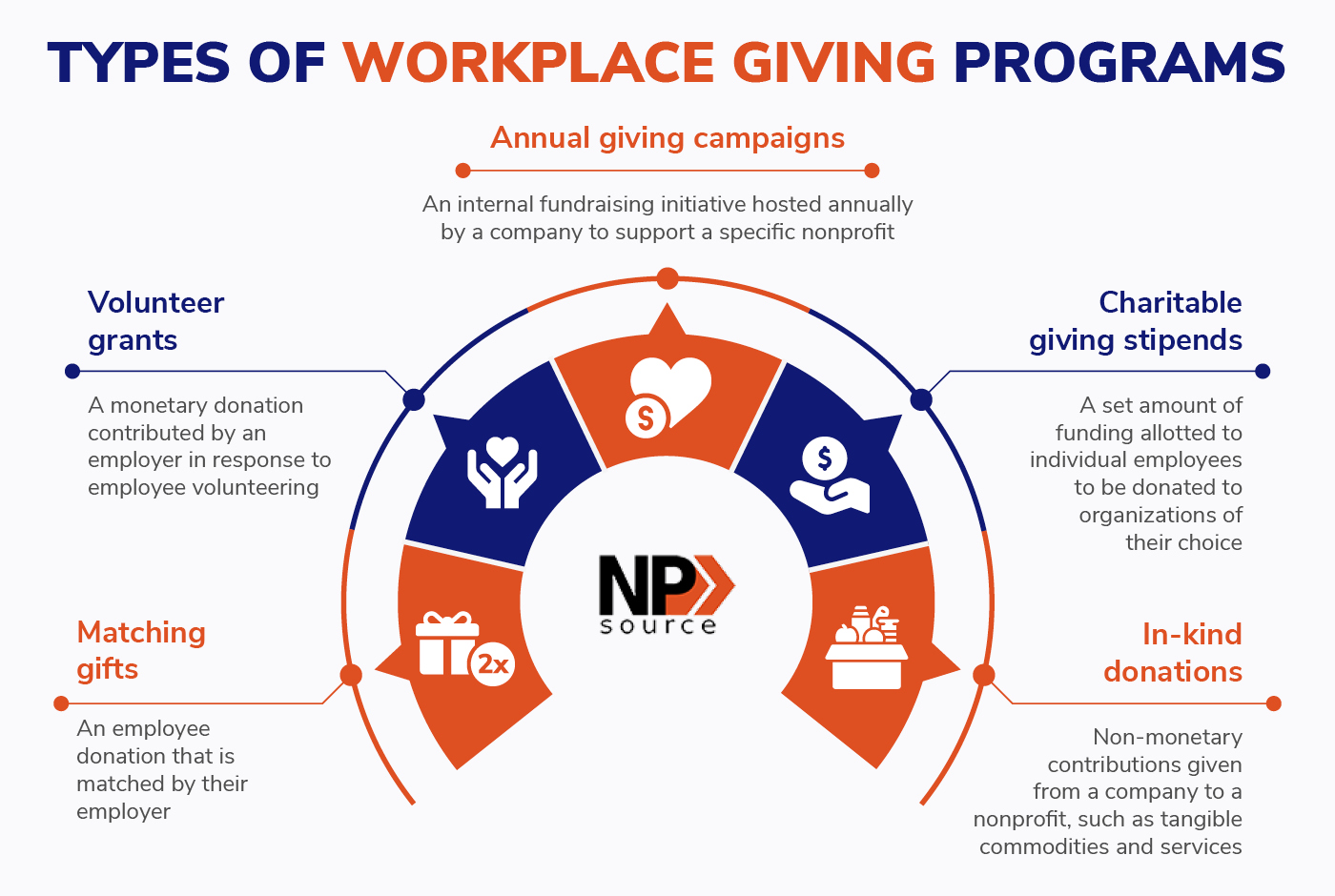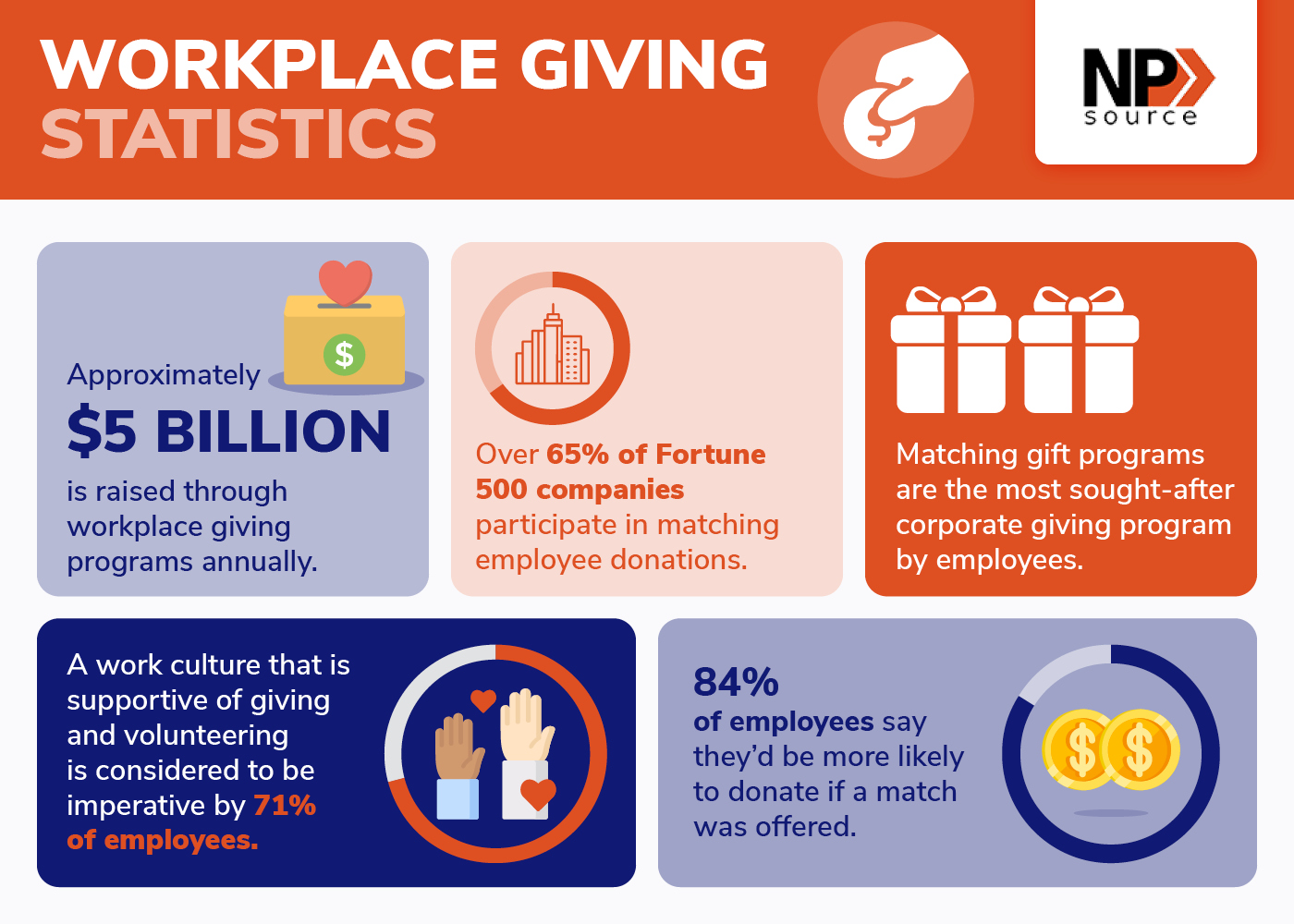From Cubicle to Community: How to Empower Workplace Giving

Nonprofit professionals have a set of top priorities—including raising funds for their mission. Company leaders, on the other hand, know the value of retaining employees, boosting their company’s reputation, and impacting their community. Workplace giving can achieve all of these objectives and more with a carefully developed program, which is why we’ve created this guide! We’ll cover the following topics:
- What is workplace giving?
- What are the benefits of employee giving programs?
- How to launch employee giving programs
- How to increase workplace giving participation
Let’s take a closer look at workplace giving basics and how you can develop employee giving programs that positively affect your team and your community!
What is workplace giving?
Have you ever heard a nonprofit say something like, “Made possible by…” or “Thanks to our friends at…”? If you’ve witnessed a company sponsor a charitable organization’s work, you’ve likely seen corporate philanthropy in action! One way for corporations to practice philanthropy is workplace giving, which relies on employee participation:

Workplace giving is an employer-sponsored giving program that helps employees contribute to charitable causes. These programs can vary in nearly every aspect, from the type of gift to the organizations supported.
Types of workplace giving programs
Diversified workplace giving initiatives grant employees the freedom to donate however they choose, increasing the likelihood of their participation. From corporate volunteerism to charitable donations, consider implementing several programs to appeal to as much of your staff as possible.
Your company might choose one program to participate in or several depending on your goals and available resources. To help you make your selection, let’s explore the most common types of workplace giving programs:

Matching gifts
Also known as donation matching, this type of program is a philanthropic practice in which your company will match the charitable donations employees make.
Doubling your employees’ gifts to nonprofits is one of the most effective ways to maximize your contributions while allowing employees to support the organization of their choice. As we explain in our corporate giving trends article, companies are recognizing that matching gifts are a feasible way to engage in corporate giving year-round.
Be sure to set the following guidelines:
- Match ratio: Most companies give at a 1:1 rate. You’ll match each dollar an employee gives, doubling the initial amount. That means if an employee gives $25, you’ll also give $25, totaling $50. Some businesses offer higher ratios such as 2:1, in which case they’ll donate twice as much as the employee did.
- Employee eligibility: Which employees are eligible for your program? You might let full-time, part-time, or retired employees participate. Some generous companies match donations made by employees’ spouses, too.
- Nonprofit eligibility: Similarly, define which types of nonprofits are eligible. Do they need 501(c)(3) status? For reference, many companies designate religious organizations or schools as ineligible.
- Request deadline: Define when your employees should submit their match requests to your CSR team. Common examples include at the end of the calendar year and one year after the donation.
From here, let your employees know and then donate as the requests come in! Just be sure to confirm each donation with the nonprofit. Because of how impactful these programs are, matching gifts are one of the best workplace giving strategies your business can offer.
Volunteer grants
63 million Americans (25% of the adult population) donate to worthy causes non-monetarily by volunteering their time, talents, and energy. Companies can support their employees’ volunteer efforts by donating a set amount of money per hour through a volunteer grant. For example, you might offer $25 for every hour spent volunteering.
This type of employee giving program is a wonderful way to show employees you care about their interests. Be sure to set guidelines similar to what you set for matching gifts. Define which employees can participate, state which nonprofits are eligible, and set a volunteer grant request deadline.
What’s more, you might offer volunteer time off (VTO) to allow employees to volunteer during regular work hours. That way, they can spend their time supporting worthwhile causes without losing money on their next paycheck.
Annual giving campaigns
An annual giving campaign is a fundraising initiative that occurs once a year, typically during a specific season or around a significant date, to encourage employees to make charitable donations.
Each year, your company can organize internal fundraising campaigns to support a specific nonprofit project. When organizing these workplace giving initiatives, make sure they align with your employees’ interests.
For example, let’s say you have a lot of animal lovers in your office. You might learn about an animal shelter’s need for cat food and collect in-kind or monetary donations from employees over a set period of time. You could also gamify your campaign to encourage participation, such as through interdepartmental competition.
Charitable giving stipends
Offering charitable giving stipends involves allocating a predetermined amount of funds to each employee through a gift card or an employee giving portal. Then, employees can donate those funds to a nonprofit of their choice.
Offering this type of workplace giving is a smart move for several reasons, such as:
- Enhanced employee morale: Grant stipends boost employee morale by demonstrating that your company values their charitable interests and encourages them to be active philanthropists.
- Inspiration for giving campaigns: Employee grant stipends can serve as a catalyst for larger corporate giving campaigns and initiatives. Pay attention to the causes your employees support, so you can launch future initiatives they’ll support, too.
- Recruitment: In the job market, companies that offer grant stipends have a competitive edge in attracting top talent. After all, more individuals are seeking employers who offer opportunities to make a difference.
As you can see, incorporating grant stipends into your workplace giving program demonstrates a commitment to social responsibility. In turn, this ultimately contributes to a positive workplace culture and public image.
In-kind donations
An alternative to making monetary contributions is donating goods or services. Employers can partner with their teams by hosting an in-kind donation drive to collect tangible commodities. Let’s jump back to our animal shelter example from earlier. If an animal shelter needs cat food or dog toys, host a drive where your employees bring in those items and drop them in a bin. When your drive wraps up, someone from your team can drop off the items at the shelter.
You’re not limited to donating physical items, either. For a different take on this workplace giving initiative, employees can participate even more directly with nonprofits by donating their services, such as web development or accounting.
What are the benefits of employee giving programs?
No matter what type of workplace giving program you choose, the opportunities for engagement and growth are limitless! Consider the following statistics:

- Workplace giving has great potential for impact. Approximately $5 billion is raised through workplace giving programs annually. Over 65% of Fortune 500 companies participate in matching employee donations. That’s a lot of fundraising power for nonprofits that need the funding!
- Employees value workplaces that give. A work culture that is supportive of giving and volunteering is considered to be imperative by 71% of employees. By developing an employee giving program, you’ll cultivate a workplace culture that your team wants to be a part of—resulting in increased employee commitment to your organization.
- Employees want to maximize their gifts. Matching gift programs are the most sought-after corporate giving program by employees, with 84% saying they were more likely to donate if a match was offered. This means that employees want your help contributing to nonprofit causes!
Beyond impacting your community and employees, workplace giving can also boost your company’s brand! An established giving program can enhance your reputation in the community and create a strong network of partnerships with nonprofits.
Additionally, nonprofits can see numerous benefits from workplace giving programs, including:
- Stronger relationships, which could ultimately lead to long-term partnerships.
- A broader audience with which to share nonprofit missions.
- Cost-efficient fundraising efforts that result in large and unique gifts.
At the end of the day, workplace giving supports nonprofits with more than just monetary contributions. It creates a network of nonprofit and for-profit organizations that can work together to impact the community.
How to launch employee giving programs
Clearly, workplace giving programs are not just beneficial to nonprofits, but also popular among corporations and important to employees! To launch your employee giving program, follow these three steps:

1. Set mission-centric workplace giving goals
Before you can get started with workplace giving, you’ll need to determine the goals for your program and construct a plan for achieving those goals. You might narrow down your planning by:
- Asking for employee opinions: Don’t risk building your workplace giving program on assumptions. Survey your staff to learn which nonprofits they’d like to support and what workplace giving programs would make it easiest for them to contribute. From there, you could also create hypothetical personas to plan future initiatives. For example, you might notice that younger employees are interested in fundraisers that support higher education and build a portion of your giving program around that.
- Evaluating your mission statement: Your company’s mission statement reflects its purpose and goals, and can even relate to some nonprofit causes. Think about your mission statement and what your investment in nonprofit causes should look like to further that mission.
- Addressing community issues: Smaller companies tend to be connected to specific communities and may be able to address a more local need. For example, did your community recently experience a natural disaster? Volunteer time and efforts to clean up debris or rebuild homes might be especially valuable to the community during this time.
After evaluating the purpose of your workplace giving program, determine which initiatives will be most beneficial to help you reach your goals.
2. Invest in workplace giving software
Your company likely invests in various tools to streamline its operations, and your workplace giving program should be no different! There are numerous CSR tools available to help your company launch and manage its workplace giving program. Let’s explore a few features to prioritize.
Matching Gift Integrations
If you want to offer matching gift tools to employees, make sure your technology is equipped to do so. Ideally, the software should offer employee portals where individuals can log in to track donations, verify their eligibility, and submit match requests.
Integrations can take your CSR software’s matching gift functionality further. For example, 360MatchPro is matching gift software that empowers employees to automatically submit a matching gift request when they visit a nonprofit’s website. While this software is used by nonprofits, it also integrates with leading workplace giving platforms like Millie and POINT.
When you choose a CSR platform that integrates with nonprofits’ matching gift tools, your employees can easily research your company’s giving programs. In some cases, they can even have 360MatchPro automatically submit their match request to your CSR team.
Watch the following video for a closer look at the industry’s leading matching gift tool:
Encouraging participation in workplace giving is much easier when you choose the right tools! Before choosing a CSR tool, be sure to research your options thoroughly. Request a demo to see the software in action, and don’t be afraid to prepare a list of questions for the provider to ensure you learn everything you need to know before deciding. You can also look for software reviews online to see what other people have to say about the tool.
Volunteer Management
Workplace giving software often equips companies with volunteer management capabilities to organize, track, and promote employee volunteerism. These features are designed to encourage participation and streamline CSR efforts. Here are some examples of volunteer tools to keep an eye out for:
- Volunteer Opportunity Matching: Some employee giving software can match employees with volunteer opportunities based on their skills, interests, and availability. This ensures that employees find opportunities suited to them.
- Volunteer Event Registration: Simplify the sign-up process by enabling employees to browse and register for volunteer events or projects directly through the software’s interface.
- Hour Tracking: Your CSR platform should help track volunteer hours, ensuring accurate reporting for both employees and nonprofit partners.
- Team Volunteering: Some platforms facilitate team volunteering, so employees can form groups and participate in volunteer activities together. This is a great way to promote teamwork and build camaraderie!
- Volunteer Grant Management: If your company provides grants to nonprofits where employees volunteer, make sure your CSR software enables employees to submit grant applications and your leadership to facilitate the verification process.
These volunteer management features empower companies to effectively plan, execute, and monitor their volunteer programs, promoting employee engagement, strengthening community relationships, and making a positive social impact.
Payroll Integration
Offering recurring payroll deductions is one of the easiest ways to engage employees to participate in charitable giving. It enables them to spread their contributions over the course of a year in smaller, more manageable amounts.
If your payroll system doesn’t already enable payroll deductions for charitable contributions, you’re in luck. Your workplace giving software may facilitate this form of employee giving! Make sure your system integrates with payroll systems to enable automated payroll deductions. Employees can then specify the benefitting nonprofit, the donation amount, and the frequency of their gifts.
3. Promote your employee giving programs
Your company is likely no amateur when it comes to marketing its services, and your employee giving programs need the same level of attention in order to reach employees, community members, and nonprofit professionals.
To highlight opportunities for workplace giving, create a landing page on your website that specifically addresses the programs you offer. Leverage Google Ads to make sure anyone who searches for your company finds information about your charitable giving, driving more traffic to those landing pages.
Then, use your other channels of communication to point back to your website. For example, tease information about giving opportunities with quippy social media posts and provide the link to your landing page so that enticed followers can find more information.
How to increase participation in workplace giving
Think of your employee giving program as a partnership between your company and its employees. Together, you’ll work to make a meaningful difference—but everyone must do their part, which is why you must work to increase participation in the program.
Let’s take a closer look at how you can increase participation in your workplace giving program.
Get your executives on board
Recruit the support of your company’s executives before announcing the workplace giving program to your employees. Review your program plans and highlight the potential benefits of participating. You can even share specific nonprofits’ stories to pull at their heartstrings and inspire action.
With your company’s executives backing the program, you’ll signal to employees that the program truly reflects the mission and goals of the company as a whole.
Engage your employees
For your employee giving program to be operational, you need one factor: employee participation! Once you’ve cleared the program with executives, it’s time to start getting employees involved.
Let employees know how they can get involved through:

- Company communications: Any company-wide or team messages should include information about your workplace giving program. Include specifics about how to get involved or extra resources for making a donation. Especially if your initiative consists of several programs, you might hold a company-wide meeting to go over the program and implement instructions into future onboarding materials.
- Word-of-mouth: Encourage executives and employees to spread the word! An employee who is already excited about and engaged in the program will be the best resource for convincing other employees to get involved. They’ll act as ambassadors for your workplace giving program, garnering support on your behalf.
- Nonprofit promotion: Let the nonprofit community spread the word for you! For example, if your employees’ donations are eligible to be matched, spread the word to nonprofits! Your employees will likely pay more attention when a nonprofit they support mentions another opportunity for support.
Consider kicking off the program by having executives make the first donations. This will further solidify the company’s support of charitable giving and encourage employees to take the leap!
Share your impact
As soon as an employee gives, thank them by pointing out the impact of their contributions. You might send a digital card as a confirmation of their donation with fun animations and a quick thank-you message to show your appreciation.
Don’t stop after you’ve gotten just a few employees on board! Maintain their involvement by continually encouraging them to give. To do this, show your team what would be possible if they continued to give.
Recap your company’s giving program by sharing details such as the amount of dollars donated or volunteer hours logged. You can also highlight metrics provided by the nonprofits your efforts supported. For example, you might send a nonprofit’s impact report in a company-wide email. Highlight statistics, beneficiaries’ stories, and the results of specific fundraising initiatives to emphasize employees’ impact through the organization.
Additional workplace giving resources
Your company holds the power to engage its employees and contribute to social good through effective strategies for workplace giving. Now that you know how to get started, it’s up to you to start supporting employees’ philanthropic efforts! For more tips on promoting your employee giving program and important nonprofit causes, check out the following resources:
- Get Your Small Business on the Map: 5 Digital Marketing Tips. Wondering how your small business can make a big impact? Check out these four digital marketing tips to help promote your company’s workplace giving program.
- Google Ad Grants for Nonprofits: A Marketer’s Complete Guide. Interested in helping your nonprofit partners access useful marketing tools to spread the word about their workplace giving program? Check out this guide to Google Ad Grants!
- 219 Digital Marketing Terms & Definitions You Need To Know. Looking for tips on marketing your workplace giving program? First, you’ll need to know the terms! Check out our list of digital marketing terms to better understand your marketing efforts.




